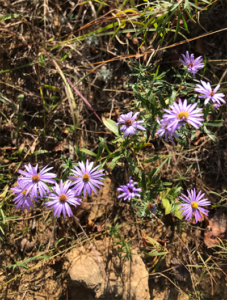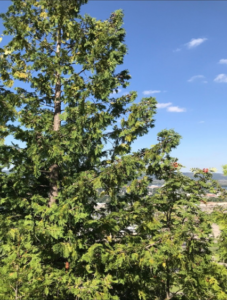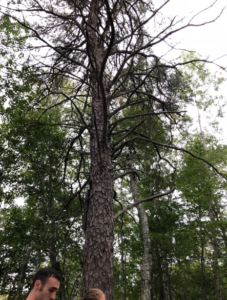Environmental biology students Angela Soto ’19 and Erin Hettinger ’20 recently wrote blog posts for their plant taxonomy course. Check out their work!
Glacial Relics and Goat Prairies in Winona? You’ve Got to be Bluffing.
Upon arrival to Winona, Minnesota, one might be immediately struck by the beauty and expansiveness of the bluffs along the Mississippi River. These bluffs and valleys were formed naturally, thousands of years ago, by the movement of glaciers through the area. On the eastern side of town, among the bluffs, one large rock outcrop literally sticks out among the rest. This bluff, now known as Sugar Loaf, has not only a rich history, but also diverse ecology.
Sugar Loaf, known as Wapasha’s cap by the native Dakota peoples because of its resemblance to their chief’s favored headpiece, has always been a distinct landmark for Winona that was even used to aid navigation along the Mississippi.1 In the 1800’s, European settlers came into the area and took the land from the Dakota people. In the year 1878, Sugar Loaf was bought by an Irishman named John O’Dea. O’Dea mined Sugar Loaf for its rich limestone deposits, which ultimately resulted in the now distinctive 85-foot tall limestone outcrop. After many years of mining for limestone, the people of Winona started to protest any further degradation of the city’s signature bluff-face. Eventually, in 1950, the land was bought back by the Winona chapter of the Daughters of the Revolution. It was later given back to the city and deemed a historical marker that is now protected and enjoyed by many.
 The ecology of Sugar Loaf bluff is something of great note as well. As one makes their way up the bluff, the cool shaded forest with its rich soil, seems to quite suddenly shift into a very dry sand, seeming almost as if you took a wrong turn and ended up at the beach! With the dramatic change in soil composition comes a drastic shift in plant communities. The towering trees and forest undergrowth give way to small shrubs, grasses, and wildflowers not much taller one’s knees.
The ecology of Sugar Loaf bluff is something of great note as well. As one makes their way up the bluff, the cool shaded forest with its rich soil, seems to quite suddenly shift into a very dry sand, seeming almost as if you took a wrong turn and ended up at the beach! With the dramatic change in soil composition comes a drastic shift in plant communities. The towering trees and forest undergrowth give way to small shrubs, grasses, and wildflowers not much taller one’s knees.
This area on the south-western facing bluff can be classified as a goat prairie. Goat prairies are known for being very steep and dry because of their prolonged exposure to sunlight, and are often dependent on wildfires to keep shrubs and trees from encroaching and outcompeting native species.2 Since the area has become more developed however, these fires don’t occur naturally anymore, and work has to be (and is being) done to cut back invasive and native shrubs such as buckthorn and junipers from taking over the once common but now rare goat prairies.3 Within the area of prairie still present on Sugar Loaf lies beautiful native wildflowers such as: compass plant (Silphium laciniatum L.), silky aster (Symphyotrichum sericeum)- pictured above to the left, rough blazing star (Liatris aspera), prairie sagewort (Artemisia frigida), and many others.
 On the north-east slope of the bluff, overlooking downtown Winona and the Mississippi River the goat prairie shifts to an entirely different habitat where hardwood forests take over. Unlike the southern facing goat prairie the north-eastern side of the bluff gets very little sunlight and large amounts of rain. Because of this, smaller flowers and shrubs give way to large hardwoods, some pines some maples. On this side of Sugar Loaf there is one tree, the northern white cedar (Thuja occidentalis) pictured to the right, a species in the Pine family that is quite rare in this area. This species of tree is found most commonly throughout northern Minnesota, with Winona being rather far south for its typical range. With very few naturally occurring this far south in Minnesota, it is thought that this white cedar may be what is called a glacial relic, an artifact that was carried by glaciers and was able to grow and survive in isolated areas.
On the north-east slope of the bluff, overlooking downtown Winona and the Mississippi River the goat prairie shifts to an entirely different habitat where hardwood forests take over. Unlike the southern facing goat prairie the north-eastern side of the bluff gets very little sunlight and large amounts of rain. Because of this, smaller flowers and shrubs give way to large hardwoods, some pines some maples. On this side of Sugar Loaf there is one tree, the northern white cedar (Thuja occidentalis) pictured to the right, a species in the Pine family that is quite rare in this area. This species of tree is found most commonly throughout northern Minnesota, with Winona being rather far south for its typical range. With very few naturally occurring this far south in Minnesota, it is thought that this white cedar may be what is called a glacial relic, an artifact that was carried by glaciers and was able to grow and survive in isolated areas.
The rich ecological diversity of Sugar Loaf bluff is truly a treasure that deserves to be preserved. From a simple hike, to rock climbing, to enjoying and learning about two different, but important native landscapes that once took over much out southern Minnesota, Sugar Loaf has something to offer for everyone. For more information on how to explore this beautiful and historic landmark click here.
References:
1 Christenson, Jerome. “Whittling away at Sugar Loaf.” Winona Daily News, 2 April 2015, www.winonadailynews.com/special-section/pieces-of-the-past/whittling-away-at-sugar-loaf. Accessed 30 October 2018.
2 Texler, Hannah. “Explore an Ancient Landscape.” Minnesota Department of Natural Resources, November 2015, www.dnr.state.mn.us/mcvmagazine/issues/2015/nov-dec/blufflands.html. Accessed 30 October 2018.
3 Rogers, Chris. “Restoring prairie at Sugar Loaf.” Winona Post, 9 July 2018, http://www.winonapost.com/Article/ArticleID/59908/Restoring-prairie-at-Sugar-Loaf. Accessed 30 October 2018.
4 Pictures of silky aster and northern white cedar taken by Josh Balsiger
Your Tree Can Tell a Story
By Angela Soto

Forest consisting of mainly coniferous trees. Photo Taken at Long Lake Conservation Center in Palisade, MN, 2018.
Do you remember the tree that grew in the backyard of your childhood home? Or the one on the school playground, that you could go and sit under just to pass the time on a warm spring day? Most likely not, but even if you knew exactly which one it was, what else would you be able to say about that kind of tree? If you’ve ever gazed at a tree and wondered how it came to be, and why it looks like it does, you’re not alone.
Much of the information about general tree ID and ecology that pervades modern American culture leaves much to be desired. “Wait, you’re telling me that all coniferous trees AREN’T pine trees?” -Yes, but also so much more than that. For many of us, a tree can signify a type of special and personal relationship to something: a memory, a person, or a significant era in our lives. What many people aren’t aware of is the other relevant information that a tree can provide us with.
Like humans, trees are a product of the environment that they were born in. Much like how a stressful environment in the early years of life can lead to individuals with a higher tolerance for stress and a greater amount of resilience, so too can a tree tell a story of how it came to be, and what the environment around it was like when it was young. Additionally, learning more about the different adaptations a tree has can give us another clue for its history, and its role in the ecosystem.
The jack pine (Pinus banksiana Lamb.) is a familiar face in the woods of Northern Minnesota. As a part of the Pinaceae (Pine) family, the jack pine shares many qualities with the prevalent eastern white and red pine species, which are often more easily recognizable as a classic version of a Pine tree. These three together constitute the three pine tree species native to Minnesota, with the jack pine being the most common species of pine in the state. To those who are unfamiliar with the jack pine, it may look intimidating at first-or almost like there’s something wrong with it! However, this couldn’t be further from the truth.
The tree’s reputation and its “spooky” appearance in its older years actually provides us with an opportunity to learn about its ecological significance. After all, the jack pine just plainly stands out, not only from its close relatives, the eastern white pine and the red pine, but also from most other trees that can be found in a Mixed Coniferous-Deciduous Forest, a native plant community commonly found in Northern Minnesota. In a Mixed Coniferous-Deciduous Forest, characterized as an “Upland Zone” community type by the Minnesota Department of Natural Resources, a variety of tree species can grow and thrive. Common coniferous trees found in this community include species of spruce, balsam firs, and northern white cedars. Common deciduous trees include species of oaks and maples, as well as paper birch and quaking aspen.
The jack pine tells of a setting unbeknownst to most of us in modern society. It harkens back to a pre-colonial America, where nature ruled the landscape instead of man. The tree is known for colonizing an area after a great fire, and it frequently grows in sandy, rocky, and nutrient-poor soils. Here’s the kicker: not only are fires not bad for the tree, they are essential for their reproduction. In fact, while fires often kill the parent tree, the seeds are able to survive and quickly grow following a fire. The key to this adaptation is twofold: first, the seeds themselves are protected by the cone and sealed inside with resin, until the heat of a wildfire opens the cones and the seeds are allowed to disperse; secondly, dead branches of the tree will remain on the tree for many years, as opposed to falling off the tree shortly after death, as they will in other pine species. This allows for the branches of the tree themselves to be used as tinder in the forest fire that will simultaneously open their seeds- both mechanisms work hand-in-hand to ensure the successful reproduction of the jack pine. Additionally, this is what gives jack pines their characteristic “spooky” appearance! Who would’ve guessed that it was due to an adaptation that helped it to reproduce?
While the beloved jack pines are set to remain the most common pine in Minnesota for years to come, the species is facing a reduction in number with the sharp decline of forest fires since pre-settlement times, paired with increasing expansion of agriculture and the lumber industry, where jack pines in unprotected areas are usually killed before the age of 65.
 With its future uncertain, the abundance of the jack pine in Minnesota hangs in the balance. Where at one time stood a dense forest of jack pines, might now be a potato field. Where once a forest might have been bountiful with older jack pines, we now find only a few, due to the lack of any recent forest fires. We owe it to ourselves to preserve a tree that not only holds so much personal meaning to an individual, but which provides us with indispensable knowledge and evidence of a Minnesota where forests ran rampant and life as we know it was nothing like it is today.
With its future uncertain, the abundance of the jack pine in Minnesota hangs in the balance. Where at one time stood a dense forest of jack pines, might now be a potato field. Where once a forest might have been bountiful with older jack pines, we now find only a few, due to the lack of any recent forest fires. We owe it to ourselves to preserve a tree that not only holds so much personal meaning to an individual, but which provides us with indispensable knowledge and evidence of a Minnesota where forests ran rampant and life as we know it was nothing like it is today.


